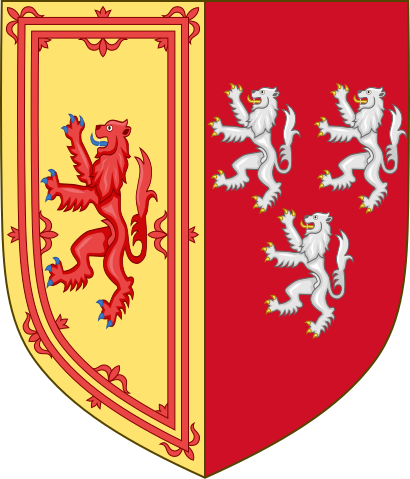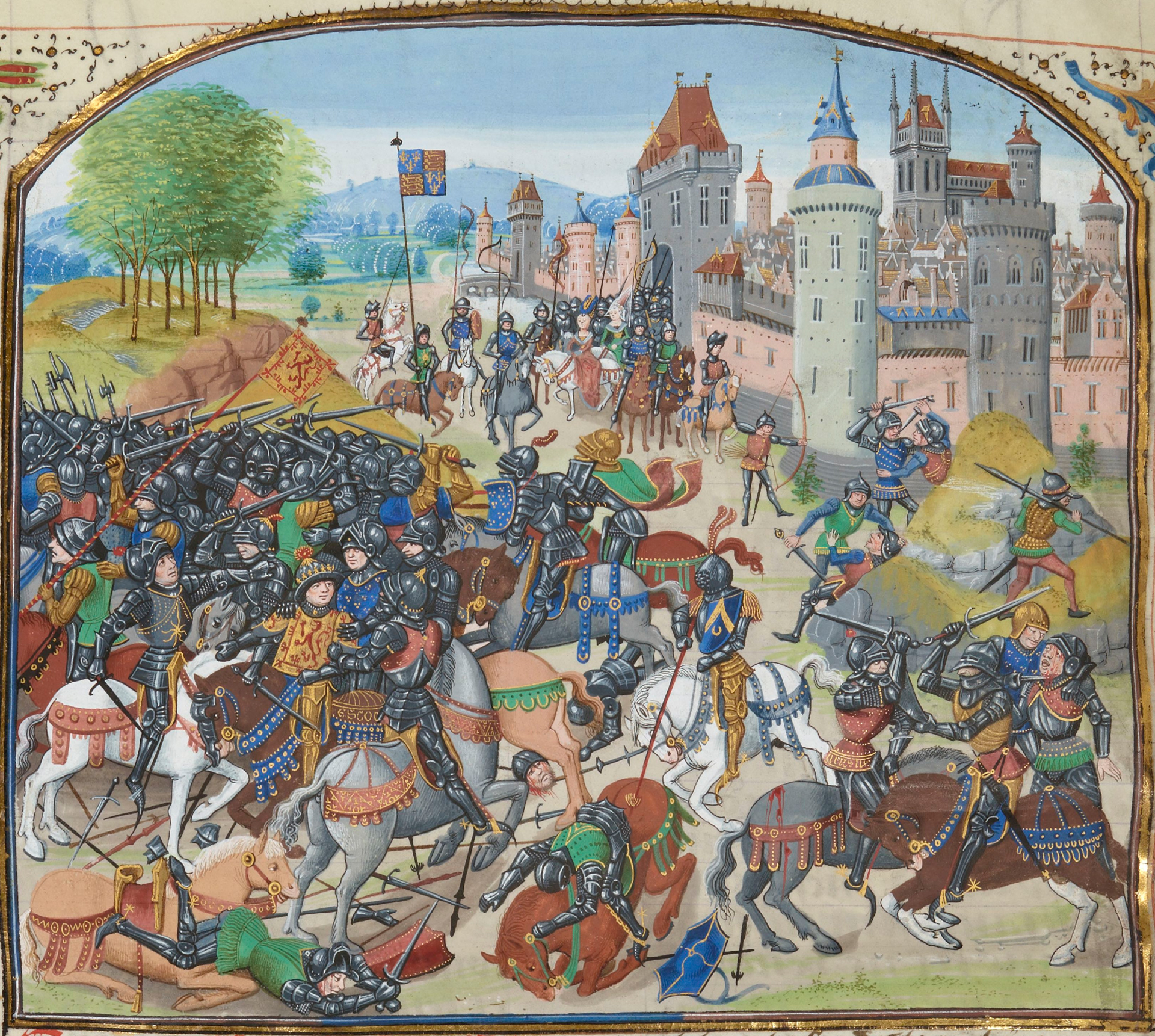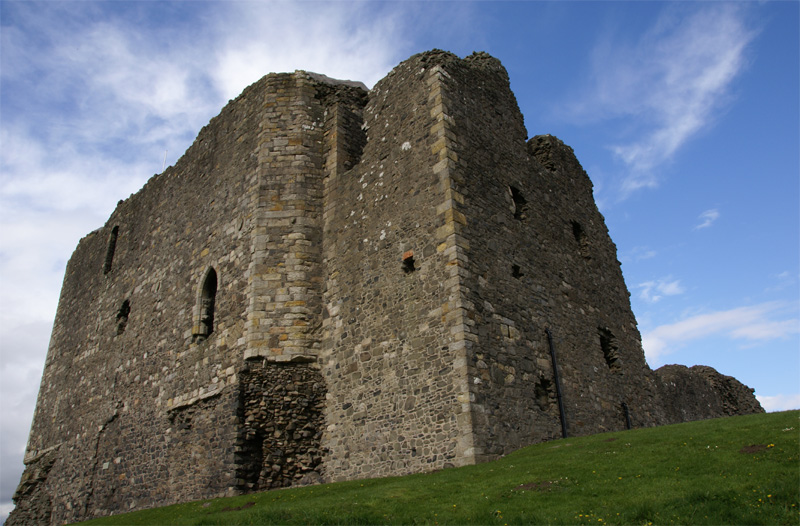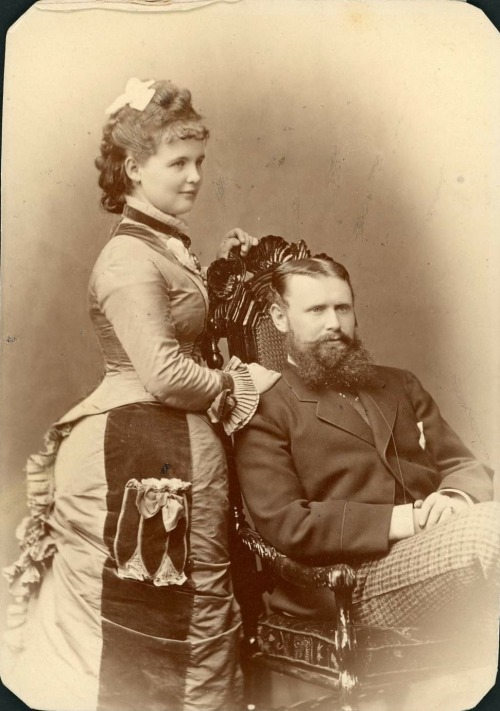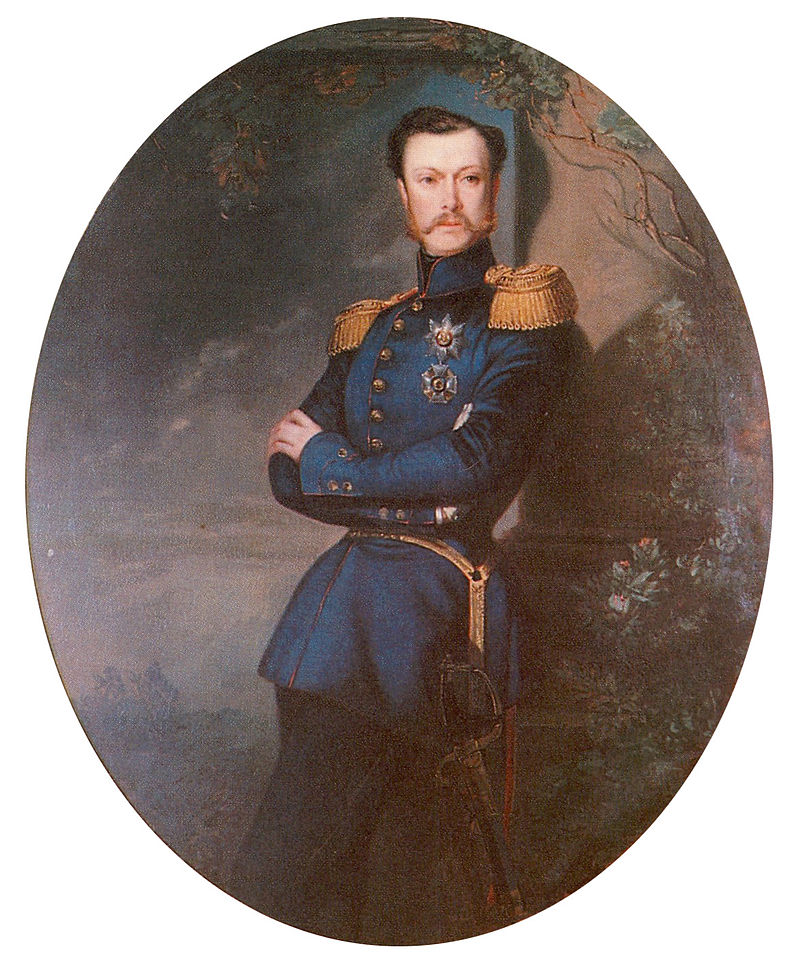by Susan Flantzer © Unofficial Royalty 2017
King Alfonso XIII of Spain and Princess Victoria Eugenie of Battenberg were married on May 31, 1906, at the Royal Monastery of San Jerónimo in Madrid, Spain.
King Alfonso XIII of Spain’s Background

King Alfonso XIII of Spain with his mother and sisters, 1897; Credit – Wikipedia
On November 25, 1885, three days before his 28th birthday, King Alfonso XII of Spain died from tuberculosis at the Royal Palace of El Pardo in Madrid, leaving two daughters and his queen pregnant with her third child. It was decided that Alfonso’s widow, born Archduchess Maria Christina of Austria, would rule as regent until the child was born. If the child were a male, he would become king and if the child were a female, Alfonso and Maria Christina’s elder daughter María Mercedes would become queen.
On May 17, 1886, Maria Christina gave birth to a son. King Alfonso XIII of Spain was the Spanish sovereign from his birth until the establishment of the Second Spanish Republic on April 14, 1931. He was given the names Alfonso León Fernando María Jaime Isidro Pascual Antonio de Borbón y Habsburgo-Lorena. His mother would remain Regent until Alfonso turned 16 and took control of the monarchy. He had two older sisters:
- Infanta Mercedes, Princess of Asturias (1880 – 1904)
- Infanta Maria Teresa (1882 -1912)
During Maria Christina’s regency, Spain lost its colonial rule over Cuba, Puerto Rico, Guam, and the Philippines to the United States as a result of the Spanish-American War (1898). In 1902, at the age of sixteen, Alfonso XIII was declared of legal age and assumed the constitutional role of head of state. The week of his sixteenth birthday was marked by festivities, bullfights, balls, and celebrations throughout Spain.
Princess Victoria Eugenie of Battenberg’s Background

Princess Victoria Eugenie with her mother and brothers, 1900; Credit – Wikipedia
Princess Victoria Eugenie Julia Ena of Battenberg (known as Ena, which will be used in the rest of the article) was born on October 24, 1887, at Balmoral Castle in Scotland, the only daughter of Prince Henry of Battenberg and Princess Beatrice of the United Kingdom, the youngest daughter of Queen Victoria. She had three brothers:
- Prince Alexander of Battenberg, later Alexander Mountbatten, Marquess of Carisbrooke (1886-1960)
- Prince Leopold of Battenberg, later Lord Leopold Mountbatten (1889-1922), hemophilia sufferer
- Prince Maurice of Battenberg (1891-1914), killed in action during World War I
Raised in her grandmother’s household, the family moved constantly between Buckingham Palace, Windsor Castle, Balmoral Castle, and Osborne House. In January 1896, Ena’s father died of malaria while en route to fight in the Ashanti War. Following his death, Queen Victoria gave the family apartments at Kensington Palace where they lived while in London. After Queen Victoria’s death in 1901, Kensington Palace became their primary residence, along with Osborne Cottage on the grounds of Osborne House.
The Engagement
In 1905, nineteen-year-old King Alfonso XIII of Spain toured Europe seeking a bride, and he made a stop in the United Kingdom where the press speculated that Queen Victoria’s granddaughter Princess Patricia of Connaught, known as Patsy, would most likely catch Alfonso’s eye. At a dinner at Buckingham Palace, Queen Victoria’s eligible granddaughters were seated around the dinner table, all aware that they had the possibility of being the next Queen of Spain. Alfonso had been seated next to Queen Victoria’s daughter Princess Helena who answered his questions about the princesses. When his eyes fell on seventeen-year-old blonde Ena, Alfonso was immediately smitten and asked, “And who is that young lady with the nearly white hair?”
Alfonso saw the tall, blond, dignified Ena again the next night at a reception. However, he forgot her name and referred to her as “the fair-haired one” and his feelings were reciprocated by Ena. A ball was held at Buckingham Palace on the third evening and it was the first time Alfonso and Ena could speak privately with each other. Because Alfonso’s English was limited and Ena spoke no Spanish, they spoke French. While dancing together, Alfonso asked Ena if she collected postcards, a common hobby for well-born women. When Ena said she did, Alfonso promised he would send her some postcards if she promised to reply.
After the London visit, the couple exchanged letters and Alfonso regularly sent her postcards, and it was through this correspondence that their courtship developed. However, there were several problematic issues. The first issue was religion. Alfonso was Catholic while Ena was Protestant. It was unthinkable that a Queen of Spain not be Roman Catholic. The second issue was the potential of Ena bringing hemophilia into the Spanish royal family. As Ena’s brother Leopold suffered from the disease, there was a chance that Ena herself was a carrier. Today we know that there was a 50% chance that Ena would be a hemophilia carrier. However, with little known about the disease at the time, Alfonso did not seem too concerned. The third obstacle was Alfonso’s mother, Maria Christina. She did not feel the Battenbergs were royal enough due to the morganatic marriage which started that family and wanted her son to marry a member of the Habsburg dynasty of Austria.
Nevertheless, Ena and Alfonso met again in Biarritz, France in January 1906 where they became unofficially engaged. Six days later, Ena went to Spain for the first time and met Alfonso’s mother at Miramar Palace in San Sebastian, Basque Country, Spain. Maria Christina finally agreed to her son’s choice of a bride and sent a letter to Princess Beatrice, Ena’s mother, telling her about the love Alfonso felt for her daughter and seeking unofficial contact with King Edward VII, Beatrice’s brother and Ena’s uncle. Several days later at Windsor Castle, King Edward congratulated his niece on her future engagement.
Ena agreed to convert to Roman Catholicism and she started religious instruction with Monsignor Robert Brindle, Bishop of Nottingham. She was officially received into the Roman Catholic Church on March 7, 1906, at Miramar Palace, and the engagement was officially announced on the same day. On April 3, 1906, King Edward VII elevated his niece’s style from “Her Highness” to “Her Royal Highness” thereby softening Maria Christina’s objection that the Battenbergs were not royal enough.
The terms of the marriage were settled by two agreements, a public treaty and a private contractual arrangement. The treaty was executed between Spain and the United Kingdom in London on May 7, 1906. One of the provisions of the treaty stated that Ena “forfeits forever all hereditary rights of succession to the Crown and Government of Great Britain.” This was solely because by marrying and becoming a Roman Catholic, Ena lost any right to inherit the British crown as a consequence of the Act of Settlement 1701. Any of Ena’s descendants who did not become Roman Catholic or marry a Roman Catholic would remain in the line of succession to the British Throne.
Wedding Preparations

Royal Palace of Madrid; Photo Credit – By Diego Delso, CC BY-SA 4.0, https://commons.wikimedia.org/w/index.php?curid=42954029
On May 24, 1906, Ena arrived in France onboard a British warship and took a special train to the Spanish border where she was met by Alfonso, the Spanish Prime Minister and the Spanish Foreign Minister who accompanied her to the Royal Palace of El Pardo in the Fuencarral-El Pardo district of Madrid. Enormous crowds assembled outside the gates of Pardo Palace and greeted the king and their future queen with loud cheering and cries of “Long live the King!” and “Long live the Queen!” Once they entered the palace, the gates were opened and the crowds were admitted to the palace grounds. Alfonso appeared on the palace balcony holding Ena’s hand, thrilling the crowd. Later in the evening, Alfonso returned to the Royal Palace of Madrid and Ena stayed at Pardo Palace with her mother until the wedding.
The Royal Palace of Madrid was a scene of constant reception of arriving delegations, many of them bringing splendid presents. Presents already fill three large salons at the palace. On May 29, 1906, many foreign royals and envoys arrived in Madrid. That night, festivities were held at Pardo Palace for guests, including a theater performance.
The streets of Madrid were colorful and full of activity. Trains continued to arrive with thousands of Spaniards and foreigners and the streets were packed with throngs of people in bright summer attire. The streets along the cortege route were colorfully decorated with floral arches, British and Spanish flags, and floral garlands on balconies. 1,200 tons of flowers had been ordered from the Canary Islands and parks and other public places were transformed into gardens by planting thousands of palms and rose bushes. Many buildings were decorated with huge crowns that sparkled at night with electric lights. Even the trolleys were decorated with streamers.
Alfonso’s presented jewelry to Ena said to be worth over one million dollars (in 1906 dollars!) including a gold crown with brilliant-cut diamonds to be worn on state occasions; a diadem; two collars (necklaces), one of pearls and the other of rubies and sapphires; a pair of gold bracelets; a pair of magnificent pendants; and a large diamond brooch. Ena gave Alfonso an exquisite jeweled sword designed in Toledo, Spain.
Wedding Guests

The Prince and Princess of Wales (the future King George V and Queen Mary of the United Kingdom) arriving at the church; Photo Credit – Archivo HUM historia urbana de Madrid
Below is a list of some of the wedding guests. It is assumed that spouses of guests were also invited, but the only spouses listed are the ones found in sources.
Family of the Groom
- Queen Maria Christina, mother of the groom
- Infante Carlos de Borbón y Borbón, brother-in-law of the groom
- Infante Alfonso de Borbón-Dos Sicilias y Borbón, nephew of the groom, heir presumptive to the Spanish throne
- Infanta Isabel Alfonsa de Borbón, niece of the groom
- Infanta Isabel de Borbón y Borbon, Countess of Girgenti, aunt of the groom
- Infanta Maria de la Paz de Borbón y Borbón, Princess of Bavaria, aunt of the groom
- Infante Fernando de Baviera y Borbón, cousin of the groom
- Princess Pilar of Bavaria, cousin of the groom
- Infanta Eulalia de Borbón y Borbón, Princess of Orleans, aunt of the groom
- Infante Alfonso de Orleáns, cousin of the groom
- Prince Genaro de Borbón-Dos Sicilias, distant cousin of the groom
- Prince Raniero de Borbón-Dos Sicilias, distant cousin of the groom
- Prince Philip, de Borbón-Dos Sicilias, distant cousin of the groom
Family of the Bride
- Princess Beatrice of the United Kingdom, mother of the bride
- Prince Alexander of Battenberg, brother of the bride
- Prince Leopold of Battenberg, brother of the bride
- Prince Maurice de Battenberg, brother of the bride
- The Prince of Wales, cousin of the bride, and The Princess of Wales (future King George V and Queen Mary)
- The Dowager Duchess of Saxe-Coburg and Gotha, Dowager Duchess of Edinburgh, aunt of the bride
- Princess Beatrice of Edinburgh and Saxe-Coburg and Gotha, cousin of the bride
- Princess Alice of Albany, cousin of the bride, and her husband Prince Alexander of Teck
- Princess Maria Carolina of Battenberg, Princess of Erbach-Schönberg, aunt of the bride
Foreign Princes
- Archduke Franz Ferdinand of Austria (heir to the Austrian-Hungarian throne) and his wife Sophie, Duchess of Hohenberg
- Prince Albert of Belgium (future King Albert I of the Belgians)
- Crown Prince Constantine of Greece (future King Constantine I of Greece) and Crown Princess Sophie (born Princess Sophie of Prussia), cousin of the bride
- Prince Andrew of Greece
- Hereditary Prince Louis of Monaco (future Louis II, Prince of Monaco)
- Prince Heinrich of Prussia, cousin of the bride
- Prince Friedrich Wilhelm of Prussia
- Prince Albrecht of Prussia, Regent of Brunswick
- Prince Luís Filipe, Duke of Braganza (heir apparent to the throne of Portugal)
- Grand Duke Vladimir Alexandrovich and his wife Grand Duchess Maria Pavlovna of Russia
- Prince Tommaso of Savoy, 2nd Duke of Genoa
- Prince Eugen of Sweden, Duke of Närke
Other Guests
- Segismundo Moret, President of the Council of Ministers
- Álvaro de Figueroa y Torres, Count of Romanones, Minister of Interior
- Juan Manuel Sánchez Gutiérrez de Castro, Duke of Almodovar, Minister of State
- Manuel García Prieto, Minister of Justice
- Amós Salvador Rodrigáñez, Minister of Finance
- Agustín de Luque y Coca, Minister of War
- Víctor María Concas, Minister of the Navy
- Vicente Santamaría de Paredes, Minister of Education and Fine Arts
- Antonio de Aguilar y Correa, Marquis de la Vega de Armijo, President of the Congress of Deputies
- José López Domínguez, President of the Senate
- Ciriaco Sancha and Hervás, Archbishop of Toledo
- José María Martín de Herrera, Archbishop of Santiago de Compostela
- Salvador Casañas and Pagés, Bishop of Barcelona
- José María Salvador y Barrera, Bishop of Madrid-Alcalá
- Eduardo Martínez del Campo and Acosta, President of the Supreme Court
- Carlos Martinez de Irujo y Alcáza, Duke of Sotomayor, Majordomo of the King
- Manuel Falcó y Osorio, Marquis de la Mina, Equerry of the King
- Sir Maurice de Bunsen, British Ambassador to Madrid
- Luis Polo de Bernabé, Spanish Ambassador to London
- William Miller Collier, American Ambassador to Madrid
- Frederick Wallingford Whitridge, American Special Envoy
Wedding Attire

Ena’s Wedding Dress; Credit – http://www.theroyalforums.com
Ena’s wedding dress was made by the Madrid dressmaker L. Heroe, who submitted several designs to Alfonso and Ena for their approval. The fabric was white duchesse satin which was embroidered by hand. In addition, point d’aiguille Brussels lace was used on the dress, veil, and train.
The bodice and skirt were embroidered with intertwined wreaths of silver roses and orange blossoms, bordered with fleur-de-lys, a symbol of the House of Bourbon. To support the enormous train, there was a court mantle, also of white satin and with the same decorations as the dress. In accordance with the strict observance of the Roman Catholic Church in Spain, the dress did not expose the bride’s decolletage or shoulders. The entire dress was given to the shrine of Nuestra Señora de la Paloma (Our Lady of the Dove) in a poor part of Madrid.
Ena wore a tiara resting on a wreath of orange blossoms. The impressive tiara, a wedding gift from Alfonso and known as “The Fleur-de-Lys Tiara”, is still in the possession of the Spanish royal family and is nicknamed “La Buena” (“The Good One”). Set in platinum, the tiara features three large fleur-de-lys motifs, each filled with large round diamonds, and connected by swirls and scrolls of larger-sized diamonds. The tiara is part of the jewelry that is passed down to Queens of Spain. Queen Sofia, the wife of King Juan Carlos I of Spain, often wore the tiara and Queen Letizia, the wife of King Felipe VI, continued the tradition of wearing the tiara.
Queen Letizia wearing the Fleur-de-Lys Tiara in February 2017
King Alfonso XIII wore the Spanish Army’s Field Marshal uniform with the blue and white sash of the Order of Carlos II. On his uniform, wore the Order of the Golden Fleece and British Order of the Garter.
Wedding Ceremony

Alfonso and Ena leaving the church
Earlier in the morning, Ena and her mother traveled from Pardo Palace to the Ministry of Marine in the center of Madrid where they would prepare for the wedding. At 8:30 AM, the wedding procession started at the Royal Palace. Church bells were ringing, artillery salutes were firing and crowds of cheering people lined the procession route.
The crowds were thrilled when the royal coaches, each drawn by eight white horses with golden and silver harnesses wearing colored plumage on their heads, appeared: the Amaranth Coach for the ladies-in-waiting, the Cypher Coach for the lords-in-waiting, the Coach of the Ducal Crown for the Infantas and Infantes, and then and the Shell Coach for Queen Mother Maria Christina. Next came the Grandees of Spain, the highest-ranking members of the Spanish nobility, in twenty-five coaches drawn by only two horses according to the Spanish protocol. The coaches of the visiting foreign royalty followed.
Next came a coach bearing a royal crown carrying King Alfonso XIII, his witness Infante Carlos de Borbón y Borbón, the widower of Alfonso’s elder sister María de las Mercedes, and four-year-old Infante Alfonso de Borbón-Dos Sicilias y Borbón, son of Carlos and María de las Mercedes, nephew of the groom, and heir presumptive to the Spanish throne.
Immediately following the king’s coach came the bride’s procession with more gala coaches carrying the lords and ladies-in-waiting and princes and princesses of the House of Battenberg. Finally in a beautiful mahogany coach, came Princess Victoria Eugenie of Battenberg (Ena) with her mother Princess Beatrice of the United Kingdom.
The Royal Monastery of San Jerónimo was regally decorated. Over the entrance was a huge canopy of red and yellow velvet embroidered with Spanish heraldic symbols and supported by gold-tipped lances. Royal guards and halberdiers stood awaiting. As the procession entered the church, the Spanish national anthem was played.
Inside the church, a majestic canopy with the arms of Spain in gold embroidery hung over a raised dais on the left side of the altar. On the dais, was a throne and two beautiful gilded armchairs with silk cushions. On the opposite side of the altar were gilded chairs for Queen Maria Christina, Princess Beatrice, the Spanish Infantas and Infants, and the members of the Battenberg family. Besides them were the foreign princes and princesses.

Credit – http://www.fororeal.net/bodasreyes.htm
As the royal procession entered the church, the congregation stood and a 200-voice choir sang a processional march. Alfonso looked calm and happy, but as usual, slightly pale. Ena entered with her mother, eldest brother, and Queen Maria Christina. Alfonso advanced to meet Ena and they stood together as the ceremony, officiated by Cardinal Ciriaco Sancha, Archbishop of Toledo, began. The hour-long ceremony ended with the Papal Nuncio, the Pope’s representative in Spain, pronouncing the papal blessing of the newlyweds and the chanting of the Te Deum, a hymn of praise.
The Bombing
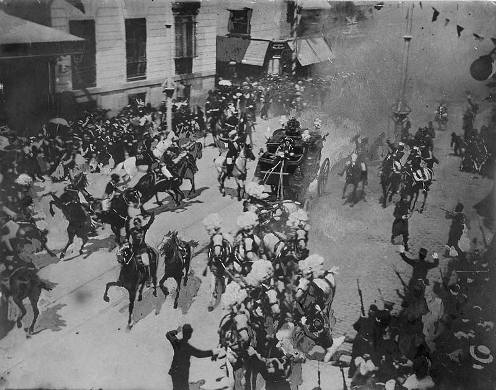
Photograph taken moments after the assassination attempt on Alfonso and Ena on their wedding day; Photo Credit – Wikipedia
At the end of the ceremony, the newlyweds left the church while the joyful crowds cheered, church bells rang, and cannons boomed. Alfonso and Ena entered the royal coach for the journey through the streets back to the Royal Palace. Crowds along the route shouted, “Long live Queen Victoria!” However, the happy day soon turned into a tragic day when a bomb, concealed in a floral bouquet, was thrown at the royal coach from a third-floor window of an inn on Calle Major, a main street in Madrid.

Building from where the bomb was thrown; Credit – By Basilio – Treball propi, CC BY-SA 3.0, https://commons.wikimedia.org/w/index.php?curid=17730999
The bomb hit the ground and exploded to the right of the royal coach between the last pair of horses and the front wheels of the coach. It would have hit the coach and most likely killed Alfonso and Ena if the bomb had not been deflected by an electric wire. Alfonso and Ena were not hurt, but the bomb killed 23 people and injured more than 100. Blood of the victims had spattered Ena’s wedding dress. Screams of the terrified crowd combined the groans of the injured and dying.
The dead included the Marchioness of Colosa and her fourteen-year-old daughter, Don Antonio Calvo and his six-year-old niece, Captain Barros who commanded the king’s escort, two other officers and six soldiers, a groom who was leading the horses, and two of the horses who were drawing the royal coach.
The sound and shock of the explosion were massive. The Duke of Cornachuelos immediately rushed forward, opened the door of the royal coach, and helped out Alfonso and Ena, who entered another coach and were quickly taken to the Royal Palace. The next day, Alfonso and Ena appeared in public in an open automobile without a military guard to reassure the people of Madrid.
Mateu Morral Roca, a Catalan anarchist, was responsible for the bombing. After the bombing, Morral tried to get lost in the crowd and was then helped and hidden by journalist José Nakens. Morral managed to escape from Madrid with the help of Nakens, but on June 2, 1906, he was recognized by several people in a village near Torrejón de Ardoz where he stopped to eat. These people warned a local policeman and after some inquiries, the policeman decided to follow Morral.
What happened next is unclear. The official investigation says that Morral surrendered peacefully, but while he was being led by the policeman to the Torrejón de Ardoz jail, Morral shot dead the policeman and then died by suicide. However, a forensic examination of the four photographs taken of Morral’s corpse indicates that the bullet wound in his chest is incompatible with both a close-shot range and the Browning pistol Morral allegedly carried.
Children
Queen Victoria Eugenie in 1918, with her six children: (from left to right) Infanta Maria Cristina, Alfonso, Prince of Asturias, Infante Gonzalo, Infante Juan, Infante Jaime, and Infanta Beatriz
Alfonso and Ena had six children:
- Infante Alfonso, Prince of Asturias (1907-1938) – married (1) Edelmira Sampedro y Robato, no children, divorced (2) Marta Esther Rocafort-Altuzarra, no children
- Infante Jaime, Duke of Segovia (1908-1975) – married (1) Emmanuelle de Dampierre, had two sons, divorced (2) Charlotte Luise Auguste Tiedemann, no children
- Infanta Beatriz (1909-2002) – married Alessandro Torlonia, 5th Prince of Civitella-Cesi, four children
- Infanta María Cristina (1911-1996) – married Count Enrico Marone, four children
- Infante Juan, Count of Barcelona (1913-1993) – married Princess Maria Mercedes of Bourbon-Two Sicilies, four children including King Juan Carlos of Spain, Spanish Royal Family descends from this marriage
- Infante Gonzalo (1914-1934) – not married
Afterword
Unfortunately, Alfonso and Ena’s marriage was not a happy one. After the birth of their first son Alfonso in 1907, it was discovered that he was suffering from hemophilia. Despite having known the risks beforehand, King Alfonso blamed Ena, and it began a rift in their marriage that would never fully heal. Their fourth and last son Gonzalo also had the disease. Both hemophiliac sons died young from internal bleeding after separate car accidents. See Unofficial Royalty: Hemophilia in Queen Victoria’s Descendants.
From 1914 on, Alfonso had several mistresses and fathered five illegitimate children. A sixth illegitimate child had born before his marriage. Following the establishment of the Second Spanish Republic in 1931, the family went into exile. Settling first in France, and then Italy, the couple eventually went their separate ways. Alfonso remained in Rome, while Ena eventually settled in Switzerland.
On January 15, 1941, feeling that his life was coming to an end, Alfonso formally abdicated his claim to the defunct Spanish throne in favor of his third son, Juan, Count of Barcelona, the father of King Juan Carlos I of Spain. His two older sons, Alfonso who had hemophilia and Jaime who was deaf, had both renounced their claims to the throne in the early 1930s. Just weeks later, on February 28, 1941, King Alfonso XIII died at the Grand Hotel in Rome.
In February 1968, Ena returned to Spain for the first time since going into exile in 1931. Staying at the Palace of Liria with her goddaughter, the Duchess of Alba, Ena was there to serve as godmother to her new great-grandson, the future King Felipe VI. Her trip to Spain would be one of her last public appearances. She returned to her home in Switzerland, and soon her health began to fail. Ena died on April 15, 1969, at her home, surrounded by her family.
Both Alfonso and Ena were buried outside of Spain due to the rule of dictator Francisco Franco. In 1969, Franco formally named Alfonso and Ena’s grandson Juan Carlos as his successor, giving him the newly created title ‘The Prince of Spain’. Franco died on November 22, 1975, and Juan Carlos was proclaimed King of Spain. Eventually, both Alfonso and Ena’s remains were returned to Spain where they were interred in the Pantheon of the Kings in the Royal Crypt of the Monastery of El Escorial.
This article is the intellectual property of Unofficial Royalty and is NOT TO BE COPIED, EDITED, OR POSTED IN ANY FORM ON ANOTHER WEBSITE under any circumstances. It is permissible to use a link that directs to Unofficial Royalty.
Works Cited
- “ALFONSO PREDICTS ASSASSIN’s SUCCESS; Is Resigned, But Regrets He Brought Victoria To Spain. BOMB THROWER’s SUICIDE Morales Killed A Guard Before He Killed Himself — Was Intercepted By An Observant Watchman.”. Query.nytimes.com. N.p., 2017. Web. 8 May 2017.
- “Boda De Alfonso XIII Con Victoria Eugenia De Battenberg”. Es.wikipedia.org. N.p., 2017. Web. 8 May 2017.
- Dennison, Matthew. The Last Princess. 1st ed. Print.
- “Diamond Tiara Fleur De Lys Ansorena | Wedding Gift Jewels| Royal Marriage Presents | Queen Victoria Eugenie Of Spain”. Royal-magazin.de. N.p., 2017. Web. 12 May 2017.
- Duff, David. The Shy Princess. 1st ed. London: Muller, 1974. Print.
- “FLOWER-STREWN STREETS FOR ALFONSO’s WEDDING; 1,200 Tons Of Blossoms Ordered From The Canaries. HOTELS CHARGING $25 DAILY Bride To Drive To The Church In A Coach Of Tortoise Shell Drawn By Eight White Horses.”. Query.nytimes.com. N.p., 2017. Web. 8 May 2017.
- Gelardi, Julia P. Born To Rule. 1st ed. New York: St. Martin’s Press, 2006. Print.
- “King Alfonso XIII Of Spain”. Unofficial Royalty. N.p., 2017. Web. 8 May 2017.
- “MADRID ENTHUSIASTIC OVER ALFONSO’s BRIDE; Princess Ena Is Acclaimed By Enormous Crowds. ROAD STREWN WITH FLOWERS The King, With His Ministers, Meets His Fiancee At The Frontier And Accompanies Her To The Capital.”. Query.nytimes.com. N.p., 2017. Web. 8 May 2017.
- “MADRID FETES GO ON AMID FEAR AND GLOOM; King And Queen Drive Unattended In An Automobile. WEYLER SERIOUSLY INJURED Twenty Killed On Thursday And Five Of The Wounded Are Dying — An Englishman Arrested.”. Query.nytimes.com. N.p., 2017. Web. 8 May 2017.
- “Mateo Morral”. Es.wikipedia.org. N.p., 2017. Web. 13 May 2017.
- “PRINCES REACH MADRID FOR ALFONSO’s WEDDING; British, German, Russian, And Other Royalties There. OUR SPECIAL ENVOY ARRIVES City Beautifully Decorated — Performance At The Pardo Theatre — Ascension Of Twelve Balloons.”. Query.nytimes.com. N.p., 2017. Web. 8 May 2017.
- “PRINCESS ENA SAVES A CRIMINAL’s LIFE; Pardon Arrives As The March To The Scaffold Is To Begin. WEDDING DRESS IS SPANISH Only The Lace Imported — Cabinet Ministers Are Enthusiastic Over The King’s Bride.”. Query.nytimes.com. N.p., 2017. Web. 8 May 2017.
- “SPANIARDS CAPTIVATED BY ALFONSO’s FIANCEE; All Classes Share The Admiration For Princess Ena. KING’s SPLENDID PRESENTS Sovereign Gives Jewels Worth Over $1,000,000 To His Bride — Palace For The American Envoy.”. Query.nytimes.com. N.p., 2017. Web. 8 May 2017.
- “SPLENDID WEDDING CORTEGE.; Brilliant Scenes In The Streets — The Marriage Ceremony.”. Query.nytimes.com. N.p., 2017. Web. 8 May 2017.
- “Victoria Eugenie Of Battenberg”. En.wikipedia.org. N.p., 2017. Web. 8 May 2017.
- “Victoria Eugenie Of Battenberg, Queen Of Spain”. Unofficial Royalty. N.p., 2017. Web. 8 May 2017.



















